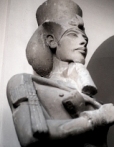This is the first article in a four part series that tells of the rise and fall of Virtudyne, one of the largest privately-financed ($200M) disasters in our industry. Though all names have been changed to protect the guilty, I've worked very closely with Rob Graves (the submitter) to ensure that this presentation is as close to how it happened as possible.
 By most people's standard, The Founder was very wealthy. A successful entrepreneur since age seventeen, he built several multi-million dollar companies and amassed a fortune larger than that of most A-list Hollywood celebrities. He prided himself on having one of the largest private collections of Egyptian artifacts in the world and prominently displayed many of them in his Great Room. And it truly was a great room: having been to The Founder's mansion several times, Rob recalls that his two-story, four-bedroom home could easily fit inside the Great Room.
By most people's standard, The Founder was very wealthy. A successful entrepreneur since age seventeen, he built several multi-million dollar companies and amassed a fortune larger than that of most A-list Hollywood celebrities. He prided himself on having one of the largest private collections of Egyptian artifacts in the world and prominently displayed many of them in his Great Room. And it truly was a great room: having been to The Founder's mansion several times, Rob recalls that his two-story, four-bedroom home could easily fit inside the Great Room.
The Founder was at home one day, doing whatever retired rich people did in 1999, and became extremely aggravated with how slow his brand-new, top-of-the-line computer was running. While cursing Microsoft Office, he had an "ah-ha" moment: he could build a better Microsoft Office.
Recalling his days as a Digital PDP-11 programmer, he knew that he could write financial software that would support fifty users, perform great, and run in 256-bytes of memory. Given the monumental advances in the twenty-years since he coded, he was elated just to think what would be possible with a bunch of top-notch programmers such as himself. He wondered just how many people it would take to build a Microsoft Office killer.
 One thing led to another and Virtudyne was born. Its goal was modest: become the next Microsoft Office killer. The Founder hired his long-time colleague as the Chief Information Officer and together, they would create The Plan. It was simple: develop an internet/intranet based Office/Collaboration system that would deliver "90% of functionality that 90% of [Microsoft Office] users use."
One thing led to another and Virtudyne was born. Its goal was modest: become the next Microsoft Office killer. The Founder hired his long-time colleague as the Chief Information Officer and together, they would create The Plan. It was simple: develop an internet/intranet based Office/Collaboration system that would deliver "90% of functionality that 90% of [Microsoft Office] users use."
An avid programmer himself, the CIO knew exactly how they could accomplish this. He convinced The Founder that, with a handful of programmers helping him, he could develop a client/server Microsoft Office Killer using Visual Basic 6. And with the latest hardware available, their application could easily scale to support twenty million users using one, maybe two servers. And best of all, it would all take only six months to create.
It was the perfect opportunity to jump on the .com bandwagon. They just could feel the IPO beckoning them. The Founder invested a few million of his own dollars and the CIO started hiring.
One of the first people the CIO approached was Rob Graves. He wanted Rob to become the database administrator, telling him only that Virtudyne was a pre-IPO startup bankrolled by The Founder. As tempting as it was, Rob had a second kid on the way and declined the offer. The CIO would have to find another DBA for the project.
What better place to find a DBA than the same place he turned for the rest of the initial hiring: the local Visual Basic special interest group. In fact, not only did he find a DBA at the SIG, he found one that proclaimed to be one of the greatest DBA in the world. And not because he possessed extensive database administration skills, but because he was willing to admit to The Truth: with the GUI-tools and automagic processes that modern databases offer, all those extensive database administration skills are meaningless.
Sadly, the DBA was one of the more talented members of the initial Virtudyne team.
Next Article: Virtudine: The Gathering. It's what happens when you give this team tens of millions of dollars to develop a client/server Microsoft Office Killer using Visual Basic 6

